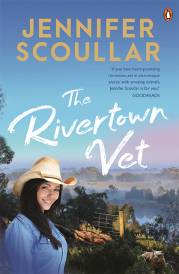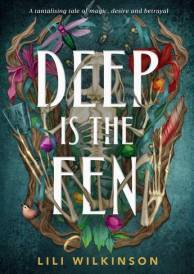Francesca Capaldi Snoopy and Charlie Brown: The Peanuts Movie
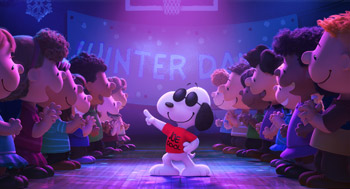
Francesca Capaldi Snoopy and Charlie Brown: The Peanuts Movie
Cast: Francesca Capaldi, Noah Schnapp, Venus Schultheis, Mariel Sheets, Bill Melendez
Director: Steve Martino
Genre: Family, Animation
Rated: G
Running Time: 93 minutes
Synopsis: Snoopy embarks upon his greatest mission as he and his team take to the skies to pursue their arch-nemesis, while his best pal Charlie Brown begins his own epic quest back home.
Snoopy and Charlie Brown: The Peanuts Movie
Release Date: January 1st, 2016
About the Production
The Legacy Of Charles M. Schulz
On October 2, 1950, Charles M. Schulz introduced the characters of Charlie Brown, Shermy and Patty in just seven newspapers, launching a 50-year journey for the cartoonist that forever changed the landscape of popular culture and humor. Schulz's comic strip was hailed as one of the greatest of the twentieth century, and his characters launched a bona-fide industry, while providing a much-needed voice for the underdog, via Charlie Brown.
Charlie Brown holds a unique position in pop culture. He has the distinction of being the only Peanuts character to appear in both the first comic strip on October 2 1950, and in the last strip on February 13, 2000. (Snoopy did not make an appearance until October 4, 1950).
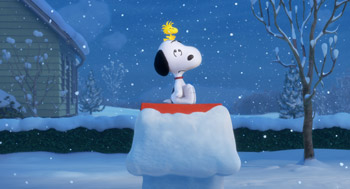 Through all of life's trials and tribulations"including a kite-eating tree, a losing baseball streak or the blunt advice of Lucy Van Pelt"Charlie Brown persevered. His eternal optimism gave us hope, which made him relatable to readers all over the world.
Through all of life's trials and tribulations"including a kite-eating tree, a losing baseball streak or the blunt advice of Lucy Van Pelt"Charlie Brown persevered. His eternal optimism gave us hope, which made him relatable to readers all over the world.
'Charlie Brown gets referred to as a loser all the time," laments Craig Schulz, the son of Charles M. Schulz and one of Snoopy and Charlie Brown: The Peanuts Movie's writers and producers. 'But in reality, Charlie Brown is a winner because he never gives up. We all lose a lot more than we win, and who better than Charlie Brown to teach us that?"
With a knack for social commentary, Charles M. Schulz created characters and storylines rich with wit, sarcasm, humor and heart. In the mid-1960s, he introduced the character of Peppermint Patty. A tomboy at heart, she excelled in sports. In the 21st century, that seems par for the course, but in the 1960s, the introduction of girls playing sports on the same team as boys was nearly a decade ahead of its time. A few years later, in 1968, Schulz introduced the first black character to the strip, Franklin, as a classmate and teammate of Peppermint Patty and Marcie.
Schulz put into just four panels the world he saw unfolding around him. 'I always thought of my dad as the great observer," recalls Craig Schulz. 'No matter where he was or what he was doing, he would find a comic strip in the moment. He never missed an opportunity to tell a story."
Without realizing it, Charles Schulz had the uncanny ability to seamlessly weave relevant topics into the panels of his strip as if they were self-evident. 'Through it all my dad never took advantage of his position. In 50 years, he never turned cynical about the world around him and that paid off. People genuinely care about these characters," says Craig Schulz.
The universal appeal of all Peanuts characters"encompassing Charlie Brown's eternal underdog status, Linus' heart, Franklin's philosophy, Marcie's introspection, Lucy's crabbiness, Sally's unrequited affection for her Sweet Babboo Linus, and Snoopy's many personas" is the reason the strip and its characters have remained relevant as Peanuts celebrates its 65th anniversary this year.
When Peantus completed its run in 2000, the strip had an estimated readership of over 350 million, and appeared in 2,600 newspapers, representing 21 countries around the world. With a combined grand total of 17,897 strips, each one drawn, inked and lettered by Schulz (15,391 daily; 2,506 Sunday), comic reprints continue in syndication, reaching new readers every day. This year, that legacy continues with the return of the Peanuts Gang to the big screen, in Snoopy and Charlie Brown: The Peanuts Movie.
You're Going To The Big Screen, Charlie Brown
Over the years, many studios had pursued a big screen version of Peanuts, but the Schulz family resisted. Their thinking began to change when director Steve Martino expressed his passion and ideas for the project. Moreover, Craig Schulz had admired Martino's work, including the way his film Dr. Seuss' Horton Hears a Who! was true to the style of Dr. Seuss.
In 2012, Schulz phoned Fox Animation Studios executive Ralph Millero to say that he had a script that he had written with his son Bryan Schulz and the younger Schulz's writing partner, Cornelius Uliano. (The three screenwriters also serve as producers.) Moving with the speed of one of those fastballs that always seem to whiz by Charlie Brown, Millero took the script to Fox Animation Studios president Vanessa Morrison, who immediately set the wheels in motion. Blue Sky and Fox had accomplished what every major studio had attempted: secure the film rights to one of the world's most coveted properties.
The approach and care that Martino showed impressed the Schulz family. 'We were very lucky to get Steve on board," recalls Craig Schulz. 'Over the years, we had dealt with many people who would come in say they've grown up with Peanuts, and that they had a great story. But it's not easy to step in the world my dad created, and to understand how he drew the strip. Steve Martino got it."
Notes producer Michael J. Travers: 'Working with the Schulzes and getting a story that felt true to the work of Charles M. Schulz was crucial. This film really is an extension of his legacy."
To say that Martino felt some pressure would be an understatement. 'I thought about Schroeder and his little toy piano, and on the day we were entrusted with these icons, I felt like I had a grand piano on my shoulders. I had artists lining up outside my door!" Adds supervising animator Nick Bruno: 'It was the first time my dad called with an opinion on how not to screw up a project of ours!"
Rounding out the producing team is one of the film industry's most respected filmmakers, the multi-talented (and lifelong Peanuts fan) Paul Feig. 'I almost fainted when Ralph Millero approached me to work on the film," jokes Feig. 'It was like getting the phone call to come on board for the re-make of -Star Wars.'"
The Story's In The Pen Line, Charlie Brown
As production geared up on Snoopy and Charlie Brown: The Peanuts Movie, Martino had a particularly memorable conversation with Craig Schulz: 'Charles M. Schulz had a profound impact on me as a child and as an artist," says Martino, 'and in one of our initial meetings, Craig stopped me and said, -All of my dad's friends referred to him as Sparky, so if we're going to be on this journey together, that is what you should call him.' That was such a great honor."
To kick-off production, Craig Schulz brought acclaimed artist Tom Everhart to Blue Sky Studios to meet with the filmmakers and artists. Everhart is known for his larger-than-life interpretations of Snoopy, Charlie Brown and the rest of the Peanuts Gang, which have been exhibited in galleries around the globe"including the Louvre Museum in Paris, the Los Angeles County Museum of Art, the Museum of Fine Arts, in Tokyo, and of course, the Charles M. Schulz Museum and Research Center in Santa Rosa, California, a museum dedicated to the work and legacy of the famed cartoonist.
In a discussion about his careful study of Charles M. Schulz's work, Everhart projected images of the cartoon strip on a movie screen to show the details of Schulz's black ink lines.
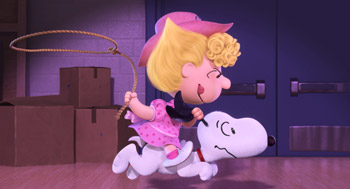 'When Tom blew up the strip, we saw such detail in the ink and literally saw story in the line. It was incredible," says Martino.
'When Tom blew up the strip, we saw such detail in the ink and literally saw story in the line. It was incredible," says Martino. 'It really was a paradigm shift for us," adds art director Nash Dunnigan. 'We knew then we had our launching pad for the look and style of the characters and production design."
Admit it: At one point in your life, you doodled a version of Snoopy or his doghouse on a school notebook… or scribbled the iconic zig-zag of Charlie Brown's sweater. Or perhaps you traced the characters from the Sunday comics. 'When I was younger, I thought, I can draw Charlie Brown; it's simple,' says Martino. 'But when you try to capture Charles M. Schulz's work, it's daunting!"
Pack Your Bags, Snoopy! You're Going To Santa Rosa!
To capture the characters' unique traits, Martino and producer Michael J. Travers immersed the crew in the world of Peanuts. They began that journey with a visit to the Charles M. Schulz Museum and Research Center.
The museum is home to thousands of original Peanuts comic strips, making it the single largest collection of the cartoon in the world. It also holds hundreds of Schulz's sketches, book illustrations, personal artwork, and early drawings. The accompanying research center includes an impressive library, along with letters, photographs, interviews, and unique Peanuts ephemeral items.
'The folks at the Schulz Museum were phenomenal," says Martino. 'They opened up their archives to us and were extremely welcoming."
For insight into the subtleties of Schulz's work, the artists, animators and story team turned to Paige Braddock, of Charles M. Schulz Creative Associates. As Creative Director, Braddock is responsible for the look and creative development of all Peanuts-related products worldwide, as well as the editorial direction of the publishing initiatives. 'Paige was an invaluable resource to all of us," says Martino. 'She was the last artist to work and train with Sparky."
Braddock gave the team from Blue Sky a nugget of advice that could be summed up in one word: Relax. 'Schulz's line was loose and organic. You can't even get close to that line quality if you can't relax," says Braddock.
She reassured the artists they were not alone in feeling a bit overwhelmed by the challenges in mastering the characters, especially Charlie Brown's head. 'It is nearly impossible to get right when you first start working with the character, and if it is off in the least, it really stands out," says Braddock.
Story artist Karen Disher traveled to Santa Rosa for what would become the first of many expeditions. A Peanuts fan since childhood, she still learned much from these visits. For example, she notes, 'Charlie Brown's lines are deceptively simple. It was amazing how much emotion he Charles M. Schulz could get from simple little dots, lines and squiggles. And that's hard to replicate."
The entire Blue Sky team knew they would need to push the envelope to bring to life the screenplay by Craig Schulz, Bryan Schulz and Cornelius Uliano.
Originally, the writers thought about focusing the story on Snoopy, with Charlie Brown relegated to a secondary storyline. But they quickly decided against that direction, knowing that too much of Snoopy could overpower the film's narrative. 'My dad had that same problem with the strip," recalls Craig Schulz. 'He was constantly reining in Snoopy!"
To balance the story, it was decided to include the entire cast of Peanuts characters, including some of its lesser-known members.
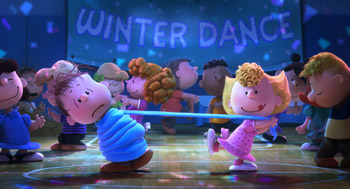 'It was Steve Martino who suggested we expand the world by bringing in the characters that everyone wants to see and to broaden the scope and the message," recalls Craig Schulz.
'It was Steve Martino who suggested we expand the world by bringing in the characters that everyone wants to see and to broaden the scope and the message," recalls Craig Schulz. At its core, Snoopy and Charlie Brown: The Peanuts Movie is about everyday anxieties we encounter while growing up, going to school, and dealing with the perceptions people have about one another. 'We took that theme and changed the overall tone of the movie, which resulted in a stronger message, one that both adults and children can relate to," says Schulz.
Martino and his teams made certain each character received a proper introduction and point of reference. Fortunately for the filmmakers, they had a set of well-established characters with strong voices created by Charles M. Schulz.
'What Sparky did so brilliantly for 50 years was to show the world it's okay to express your emotions, anxieties, hopes and fears, without a filter," says Martino. 'We see a little bit of ourselves in each of the characters, and that is what makes them so relatable. Rather than internalizing the characters' emotions, Schulz allowed them to be expressed openly, and we've stayed true to that narrative.
'One of the challenges in animation is creating characters that are interesting and have depth, so that when you put them together, you're able to create interesting scenarios and a compelling story," Martino continues. What Sparky has provided us with through all the years of the strip are really great characters. He wrote about universal topics that resonated with all of us, coming out of the voices of kids. They really are adults in children's bodies."
Martino was especially intrigued by Charlie Brown. 'Everybody's got a little piece of Charlie Brown in them," Martino explains. 'What's great about the character is that he operates on such an extreme level, which always makes you feel better about your -Charlie Brown-ness.' We've all been in those awkward situations and we've all had failures. Charlie Brown teaches us that in the midst of all that, you can pick yourself up and try again. So it was very important for us to capture that spirit in his expressions."
Back To School
For the daunting task of leading the team of animators responsible for bringing the characters to life, Martino turned to three of Blue Sky's seasoned artists: supervising animators Nick Bruno and Scott Carroll, and lead animator Jeff Gabor. All are ardent fans of Charles M. Schulz. 'We wedged ourselves onto this project," jokes Carroll.
Together, they were responsible for training, supervising and most importantly, keeping on-model a team of 100 animators. Stressing clarity, focus and simplicity, Bruno, Carroll and Gabor had to introduce an animation style that was new to nearly everyone working on the film. Each animator joining the team attended 'Van Pelt University," a crash-course in the study of Charles M. Schulz's style and work.
'There was a not a lot of information to go off on from the strips, for movement," observes Gabor. 'When you start to break down Snoopy's 15 or 20 expressions, it was impossible to decipher the in-betweens for movement cues, so we turned to the specials,"
Gabor is referring to the animated television cartoons produced by Bill Melendez and Lee Mendelson. Over the years, the duo oversaw more than 40 Peanuts television specials, winning a combined total of three Emmy awards and 20 Emmy nominations. In 2015, the Emmy and Peabody award-winning 'A Charlie Brown Christmas" celebrates its 50th anniversary; to many, the airing of the special signals the official start of the holiday season. 'If you look at what Bill Melendez did, it is like you are still looking at the strip," observes Carroll. 'The style he created for the specials was in large part due to the design of the characters."
Adds Martino: 'I listened to hours and hours of taped interviews with Bill Melendez from the later part of his life, when he learned that you can't animate these characters in a follow-through fashion. That's what drove his styling."
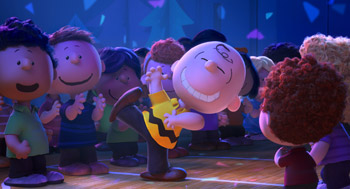 Legendary animator Bill Littlejohn (working for Melendez-Mendelson) was responsible for animating two of the most memorable scenes of Peanuts animation: Snoopy's infamous dance on Schroder's piano from the Christmas special, and the 'Red Baron" sequences from the Halloween special. Littlejohn's ability to translate Snoopy's antics and pantomime into story has been lauded and studied by aspiring animators all over the world, including those at Blue Sky.
Legendary animator Bill Littlejohn (working for Melendez-Mendelson) was responsible for animating two of the most memorable scenes of Peanuts animation: Snoopy's infamous dance on Schroder's piano from the Christmas special, and the 'Red Baron" sequences from the Halloween special. Littlejohn's ability to translate Snoopy's antics and pantomime into story has been lauded and studied by aspiring animators all over the world, including those at Blue Sky. 'Bill Littlejohn gave me my very first understanding of animation," recalls Bruno. 'When I was five years old, I received a Fisher Price Cartoon Viewer for Christmas, which came with a set of Peanuts animation. I would stay up all night stepping through Bill's masterpiece -Snoopy vs. The Red Baron.' There was something magical about understanding that Snoopy was on the losing end of a dogfight, without ever seeing his opponent!"
Adds Scott Carroll: 'If we hadn't studied Bill Littlejohn's work, we wouldn't have gotten that iconic Peanuts look and feel in the animation."
This Is Your Neighborhood, Charlie Brown
Bringing the Peanuts world and characters to the big screen in CG was a formidable task, but not just for the animators. Creating and designing the overall look of the film was just as challenging for the art department. 'I always looked at the comic strip and wanted to know a little more about Charlie Brown's world," says Martino. 'Sparky always gave us a short snapshot"a tight shot of their world."
Expanding that world fell to art director Nash Dunnigan and his team.
'Sparky is, in essence, our production designer," says Dunnigan. 'His original comic strips provide a wealth of information for our visual approach." Pouring over thousands of comic strips, the design team discovered the common threads throughout Schulz's work.
It was important to Dunnigan maintain a design consistency and avoid over-stylization. 'You can only take the level of detail in the props and environments so far before there's a disconnect," he explains. 'We didn't want to compete with the intended simplicity of the film's look."
Dunnigan challenged the team to refer back to the pen line of Schulz's work in everything they designed. They noted that Schulz's strips from the -80s and -90s had backgrounds, 'set dressing" and 'props" with a simple aesthetic, leaving the filmmakers to fill in a lot of blanks. 'We would review the strips and see only part of a lamp or couch, or just a corner of a window," recalls lead set designer Jon Townley. 'It became even more important to absorb the nuances of how he [Schulz] drew and his style."
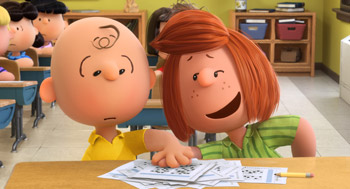 Martino knew he wanted to draw a clear distinction in the production design between the action that takes place in the beagle's fantasy sequences, where his imagination takes him to the skies as the World War I Flying Ace, and those that take place in the 'real world."
Martino knew he wanted to draw a clear distinction in the production design between the action that takes place in the beagle's fantasy sequences, where his imagination takes him to the skies as the World War I Flying Ace, and those that take place in the 'real world." The scenes set in Charlie Brown's house, in the school and throughout the neighborhood are styled with desaturated background colors, in order to not take away from the main characters' signature saturated and vibrant colors. 'Steve wanted us to feel as if we might be looking at the Sunday comic strip when we were in Charlie Brown's neighborhood or house," explains Dunnigan.
Turning to Snoopy's flights of fancy, the team wanted to push color boundaries. With Snoopy and his siblings primarily white, the deeper colors of the spectrum would accentuate their actions. One of the more charming aspects of the strip is that the characters seem ageless. 'We tried to achieve timeless styling in order to avoid dating the film"with a few exceptions," explains Dunnigan. 'We tried to stay away from concepts that were not in Sparky's strips." For example, the design team explored placing a television in the background of Charlie Brown's living room, as a prop. In researching the strips, the team noticed that the comics featured a 1970s console type television set. 'We designed and modeled the TV," recalls Nash, 'but decided not to use it as we felt it dated the scene and film. The TV introduced multi-media and a -decade' and we didn't want to introduce those concepts." The filmmakers did make one exception, by including the iconic rotary phone seen in so many of Schulz's strips and comics.
The look of Snoopy and Charlie Brown: The Peanuts Movie is a testament to the legacy of Charles M. Schulz. 'I immediately fell in love with the film's design," says producer Paul Feig. 'It doesn't challenge your perception of what Peanuts should be like, but rather, it adds to it."
It Was A Dark And Stormy Night….
When Snoopy enters his fantasy world, we the find the beloved beagle typing away, as his alter ego, the 'World Famous Author," endeavors to write the next great novel. With his trusty editor Woodstock by his side, Snoopy begins 'The Greatest Story Ever Told," with the classic line, 'It was a dark and stormy night…"
'Snoopy sees what is going on in Charlie Brown's life and takes his cues from there and we see the story progress in his fantasy world," explains Martino. The most recent twist in Charlie Brown's life is his being smitten with The Little Red-Haired Girl, the new kid in his neighborhood and classroom. Snoopy, like his pal, is pursuing a romance. Uliano notes: 'Snoopy's story is filled with love and adventure, set against the backdrop of WWI as the WWI Flying Ace sets off to win the heart of a beautiful pilot named Fifi, while facing off against his arch-nemesis, The Red Baron."
For Bryan Schulz, this part of the film's narrative was particularly satisfying, both as a writer and a fan. 'This sequence was a chance for me to finally answer a question I had been pondering for years: Why was Snoopy even chasing the Red Baron?"
Giving Voice(S) To -The Peanuts Movie'
To generations that grew up with the Peanuts specials, the voices of Charlie Brown, Lucy, Linus, Sally and the rest of gang are ingrained in our minds. Casting the right young actors would be crucial to the film's success.
Casting director Christian Kaplan conducted an exhaustive search, as he and the filmmakers met with over 1,000 hopefuls on both the East and West Coasts. To gauge cadence and rhythm, they auditioned the actors using dialogue and script passages from the Peanuts.
After an exhausting search, Martino found his Charlie Brown in ten-year-old, Scarsdale, New York resident Noah Schnapp. 'Noah has a great voice for Charlie Brown, but also has a similar temperament to the character," says Martino. 'That allowed us to rely on his natural tendencies and it really felt like Charlie Brown."
Casting the voice of Linus led to several sleepless nights for Martino. 'Linus was my favorite voice from the original Peanuts specials and was the voice I was most worried about casting," he recalls. 'Linus had this wonderful natural lisp. It was never overdone but it felt so -real.' Eleven- year-old Alex Garfin, from New York, landed the role. 'In our story, Linus is that steady, supportive friend for Charlie Brown," says Martino, 'and like Noah does with Charlie Brown, Alex has a temperament that feels like Linus."
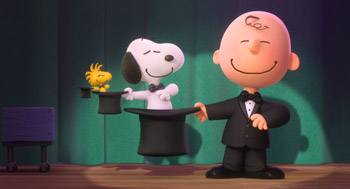 It takes a confident actress to play Lucy, and Martino found that in ten-year-old Huntington Beach, California native Hadley Miller. But rest assured, Hadley does not have the disposition of her crabby, bossy counterpart, Lucy. 'Hadley has this sweet, well-mannered personality and I wondered if she could play the bold, brash side of Lucy," says the director. But that concern was alleviated when Hadley stepped into the recording booth.
It takes a confident actress to play Lucy, and Martino found that in ten-year-old Huntington Beach, California native Hadley Miller. But rest assured, Hadley does not have the disposition of her crabby, bossy counterpart, Lucy. 'Hadley has this sweet, well-mannered personality and I wondered if she could play the bold, brash side of Lucy," says the director. But that concern was alleviated when Hadley stepped into the recording booth. 'She knocked me over with her big, bold delivery," says Martino. 'Hadley really understood Lucy. I said -Wow, that was amazing,' and then back to being just Hadley, she said in the sweetest, most polite voice, -Thank you.' She was perfect."
Although the Little Red-Haired Girl has only a few lines, she is an undeniable force in the story, as Charlie Brown's major crush. 'It was important that her voice have both sincere and sweet qualities," says Martino. Ten-year-old Francesca Capaldi, best known for work on the Disney Channel TV show 'Dog with a Blog," takes on the role.
Early in the recording process, Craig Schulz attended a voice session of Mariel Sheets, the young actress who portrays Sally Brown. Sheets had no idea who Schulz was, and during a break, Schulz recalls how she rattled off lines from the Christmas and Halloween specials, beat for beat, with perfect pacing. 'She was phenomenal," he praises.
'The great thing about working with kids is that they have extraordinary imaginations," says Martino. 'Given that they are acting in an empty room, and with no costumes, set, or props, they have only our ability to paint a picture in their minds of the scene they are playing."
Snoopy's love interest, Fifi, presented another voice casting challenge. Introduced in a special in the 1980s, Fifi never spoke, so the filmmakers had to figure out how to best approach her voice. 'We wanted to do something special yet appropriate and not just stunt-cast for the sake of stunt casting," explains Martino.
Their found their Fifi in Tony and Emmy award winner Kristin Chenoweth. Chenoweth won a Tony and Drama Desk awards in 1999 for her portrayal of Sally Brown in the musical 'You're a Good Man, Charlie Brown." This fall, Chenoweth, a longtime Peanuts fan, appears on the 50th Anniversary television special for 'A Charlie Brown Christmas" and performs 'Christmas Time is Here," the program's signature song.
Working with Chenoweth was a coming home for the team at Blue Sky, as she voiced the character Gabi in the studio's film 'Rio 2." Says Martino, 'Having Kristin add her unique talents to our film is a huge thrill for all of us at Blue Sky, and given her fifteen-year association and collaboration as part of the Peanuts family, it made for the perfect match."
In The Mix
Two-time Academy Award winner Randy Thom, Supervising Sound Editor and Supervising Sound Mixer on Snoopy And Charlie Brown; The Peanuts Movie, is no stranger to the world of animation. A legend in the craft of sound design and mixing, Thom, who is based at Skywalker Sound, has worked on over 20 animated films, including the 'How to Train Your Dragon" and 'Rio" films and 'The Incredibles" (for which is won an Oscar).
Thom embraces the myriad challenges of animation and designing a world of sound from scratch. 'It's wonderful to thing to work in a variety of styles," he says. 'What I particularly enjoyed about Snoopy And Charlie Brown; The Peanuts Movie is the directive and challenge set by Steve Martino that we stay true to the original sound of the Peanuts TV specials.
'Even though we used contemporary equipment we employed special techniques to antique them, incorporating characteristic sounds you'd recognize from the specials," Thom continues.
In a nod to the classic specials and to the legacy of Charles M. Schulz, Bill Melendez and Lee Mendelson, the filmmakers were granted access to the library of Melendez's recordings of Snoopy's voice. 'It was really important for us to use Bill's voice, so I approached his studio and secured a majority of the recordings he had made over the years," says Craig Schulz.
Entrusted with the recordings of Melendez (voicing Snoopy and Woodstock), Thom took special care incorporating them into the film. 'We studied Bill's voice and the recordings he made at the time," explains Thom. 'He would record himself doing just hums and purrs and whistles and modulate his voice up and down, and then he would later alter the pitch higher so that it was a funny little creature. The trick of course is to invent a language that is expressive emotionally, but isn't comprised of words but instead sound halfway between an animal sound and human vocalization. It needed to be funny when appropriate and of course affectionate when appropriate."
Cue Mestro, Schroeder
Snoopy and Charlie Brown: The Peanuts Movie features the iconic music of Vince Guaraldi, who composed the beloved 'Linus and Lucy" song from the television specials. 'Let me put your concerns to rest," confirms Martino, 'the -Linus and Lucy' song and all the cues you know and love are in the film!"
Martino turned to longtime Peanuts collaborator, jazz legend David Benoit, to perform the memorable title tracks for the film. To bring to life the iconic 'voice" of Ms. Othmar (the kids' teacher) and all the other adult voices in the cast, the filmmakers tapped New Orleans jazz legend Troy 'Trombone Shorty" Andrews.
At the helm of all the music is composer Christophe Beck ('Frozen," 'Ant Man," 'Pitch Perfect").
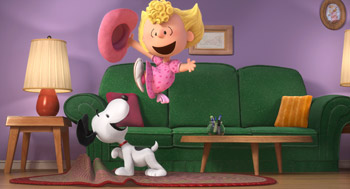 In one memorable scene, Snoopy teaches Charlie Brown to dance (so he can impress the Little Red-Haired Girl). Knowing the scene called for a song, Martino turned to one of the world's top new musical artists, Billboard Music Award winning and Grammy nominated Meghan Trainor, to pen an original tune for the film. 'Meghan has written a wonderful song that expresses Charlie Brown's optimistic attitude as he works with Snoopy to become a better dancer," says Martino. 'She is such an amazing singer songwriter and a shining example of the thematic heart of our story."
In one memorable scene, Snoopy teaches Charlie Brown to dance (so he can impress the Little Red-Haired Girl). Knowing the scene called for a song, Martino turned to one of the world's top new musical artists, Billboard Music Award winning and Grammy nominated Meghan Trainor, to pen an original tune for the film. 'Meghan has written a wonderful song that expresses Charlie Brown's optimistic attitude as he works with Snoopy to become a better dancer," says Martino. 'She is such an amazing singer songwriter and a shining example of the thematic heart of our story." Trainor met with the team at Blue Sky and seemingly overnight captured the essence of the film in song. 'Musically, Meghan had me from her very first rough demo," Martino says. 'My foot was tapping and I had a huge smile on my face as I could see this moment in the movie being lifted by her unique talents."
Trainor commented: 'As a lifelong fan of Charlie Brown, Snoopy and the rest of the Peanuts Gang, I was thrilled to be offered the chance to see an early version of Snoopy and Charlie Brown: The Peanuts Movie"and to then be inspired to write a song that captured the film's spirit, energy and sense of joy. And it was a pleasure to work with director Steve Martino to make sure the song did right by the incredible characters and world he's bringing to the big screen." Bringing that world to moviegoers has been journey of a lifetime for Martino, and the teams at Blue Sky Studios and Fox Animation Studios. Their efforts culminate with the release of Snoopy And Charlie Rbown: The Peanuts Movie in theaters everywhere on New Year's Day, 2016.
Snoopy and Charlie Brown: The Peanuts Movie
Release Date: January 1st, 2016
MORE



